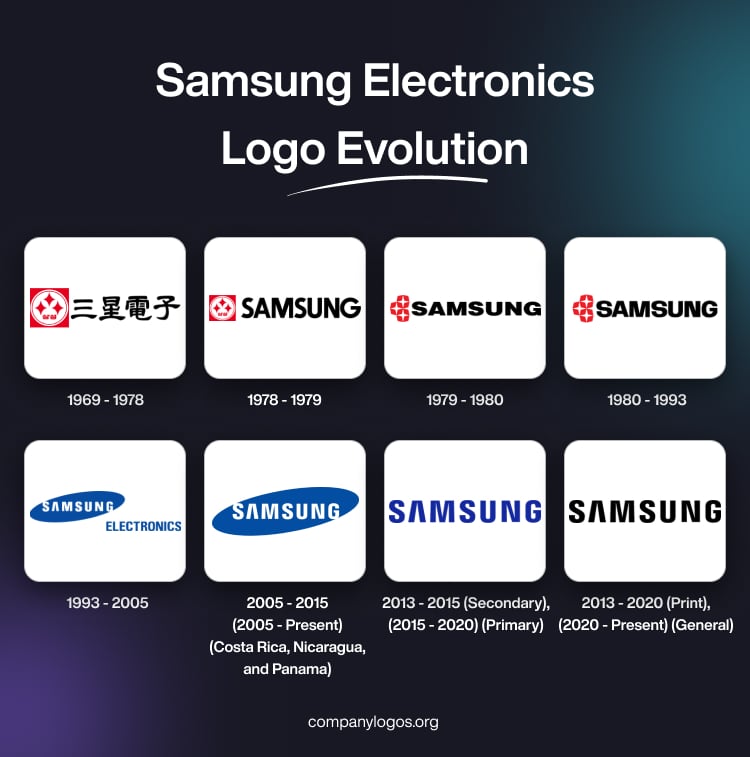
Samsung Electronics Co., Ltd. is a global leader in technology, electronics, and digital innovation. Based in Suwon, South Korea, and founded in 1969, the company is the flagship subsidiary of the Samsung Group and one of the world’s most influential manufacturers of consumer and industrial electronics. Over the decades, Samsung Electronics has become synonymous with quality, innovation, and technological leadership.
It is known for producing an extensive range of products, including smartphones, televisions, semiconductors, home appliances, and displays. The evolution of the Samsung Electronics logo is a saga of adaptability and reflects the growth of the company over the years. The article explores the various logo changes made by Samsung Electronics, among other details of the company.
The Genesis of the Samsung Electronics Logo (1969 – 1978)
Samsung Electronics came into being in 1969, and the original logo featured a graphical emblem comprising three red stars symbolising the name of the company. The stars were placed inside a white circle with a red outline inside. These elements were encapsulated within a red square. To the right of the graphical emblem was placed the name of the company in Korean script and in a black colour palette.

(1978 – 1979)
The 1978 logo iteration saw the repeat of the previous graphical emblem but had the wordmark “SAMSUNG” in black uppercase written using a sans-serif typeface.

(1979 – 1980)
In the 1979 logo iteration, the wordmark “SAMSUNG” in black uppercase and written using a flat sans-serif typeface was placed to the right of an emblem. The emblem to the left comprised three white stars enclosed within three separate red hexagons placed one below the other, respectively. The middle hexagon was placed a little left in a stack comprising three hexagons in three levels.

(1980 – 1993)
In the 1980 logo variant, the shape of the hexagons was elongated, and the letters of the brand name in black, bold uppercase were a little elongated and spaced apart from each other.

(1993 – 2005)
The 1993 logo iteration was designed by Constance Birdsall for Lippincott & Margulies, and it featured the wordmarks “SAMSUNG” and “ELECTRONICS” at two levels and opposite ends (left and right), respectively. The wordmark “SAMSUNG” in white uppercase was executed using the Linotype Univers 820 Condensed typeface.
The typeface was characterised by the letter “A” without any horizontal bar. The wordmark was placed within an angled blue oval serving as the background. The wordmark “ELECTRONICS” in blue was written using a custom sans-serif typeface to the right and set against a white background.

(2005 – 2015) (2005 – Present) (Costa Rica, Nicaragua, and Panama)
The 2005 logo iteration retained the previous iteration, but without the “ELECTRONICS” wordmark.

(2013 – 2015) (Secondary), (2015 – 2020) (Primary)
Designed by Brandstream, the logo first appeared at CES 2013 and depicted only the wordmark “SAMSUNG” in a custom Samsung blue colour palette. It was written using the Linotype Univers 820 Condensed typeface without any oval background.

(2013 – 2020) (Print), (2020 – Present) (General)
Samsung Electronics began to use its monochrome variant from January 2020 and was first displayed at CES 2020. Designed by Brandstream, it featured the wordmark “SAMSUNG” written in the Linotype Univers 820 Condensed typeface in modified black.

The Elements of the Samsung Electronics Logo
Font
The Samsung logo uses a custom sans-serif typeface, which is characterised by the following:
- Each letter is of the same height and spaced apart from each other for visual symmetry.
- The letter “A” does not have any horizontal bar.
Colour
The colour palette used to design the Samsung Electronics logo includes Samsung blue, black, and white. The Samsung blue colour symbolises innovation, trust, and technological precision. The colour black symbolises authority and sophistication, while white represents simplicity, purity, and openness.
The History of Samsung Electronics
Samsung Electronics was officially established on January 13, 1969, in Suwon, South Korea. The company came into being under the leadership of Lee Byung-chul, who was also the founder of the Samsung Group. Initially, the company focused on home appliances and visual display technologies and produced its first black-and-white television in 1970 in collaboration with Sanyo.
During the 1970s, Samsung began exporting TVs globally and expanded its product range to include refrigerators, washing machines, and microwave ovens. It also formed subsidiaries such as Samsung-Sanyo Electronics and Samsung Electro-Mechanics to strengthen its component manufacturing abilities. In 1978, Samsung merged operations under Samsung Electronics Co., Ltd, and consolidated its semiconductor, TV, and appliance divisions.
The 1980s marked the transition of Samsung Electronics into a global technology powerhouse. In 1980, the company acquired Hanguk Jeonja Tongsin and entered the telecommunications sector. Thereafter, it started producing early mobile and car phones. Besides, it established its first R&D centre in 1980 and began producing computers, thereby marking its entry into the information technology sector.
The company showed its global ambitions by launching its German sales office in 1982. By 1987, Samsung had opened the Samsung Advanced Institute of Technology (SAIT) to lead semiconductor and display research. Its early semiconductor development made Samsung a major force in memory chips by the end of the decade.
In the 1990s, under Chairman Lee Kun-hee, the company initiated the “New Management” strategy that focused on quality over quantity. In 1992, Samsung became the world’s largest producer of DRAM chips and soon began developing its first mobile phone systems. It invested in design centres in San Francisco and Milan, which reflected its growing focus on aesthetics and user experience.
By 2002, Samsung launched 1Gb NAND flash memory and cemented its dominance in semiconductor innovation. In 2006, it became the world’s top TV manufacturer by sales, a position it has continued to maintain ever since. The late 2000s also saw groundbreaking products being made by Samsung Electronics, such as LCD TVs and Blu-ray players.
Samsung Electronics’ global profile rose with the 2010 release of the Galaxy S smartphone. It was followed by innovative devices like the Galaxy Note (2011) and Galaxy Tab series. Samsung Electronics’ advanced display technologies led to the creation of Super AMOLED and QLED TVs.
The company diversified into IoT, wearables, and biotechnology as well. It did so by acquiring firms such as SmartThings and Viv Labs to enhance AI and smart home capabilities. In 2013, Samsung Display Co., Ltd. was formed through the merger of mobile and LCD display divisions.
In the 2020s, Samsung Electronics has continued pushing boundaries in 5G, AI, semiconductors, and sustainability. It also achieved a few milestones, such as launching foldable smartphones (Galaxy Z Fold series), producing 3 nm chips using GAA transistor architecture, and expanding global manufacturing bases in Vietnam, India, and the U.S. The company also emphasises environmental responsibility, incorporating eco-friendly materials and energy-efficient processes throughout its global operations.
Samsung Electronics remains an important subsidiary of the Samsung Group and contributes majorly to its revenue. Based in Suwon, South Korea, it has major hubs across Asia, North America, and Europe. The company’s portfolio spans semiconductors, smartphones, home appliances, display panels, and network systems, which influences nearly every sphere of modern technology.
Interesting Facts About Samsung Electronics
- The word “Samsung” in Korean means “Three Stars”. The name was chosen by founder Lee Byung-chul in 1938 to represent something “big, powerful, and everlasting like stars in the sky.”
- Samsung entered the electronics industry in 1969 and produced black-and-white TVs. Today, it’s one of the world’s largest TV manufacturers and has been holding that position for over 17 consecutive years.
- Samsung Electronics is the largest smartphone manufacturer globally and is known as the competitor to Apple. Its Galaxy lineup, launched in 2009, revolutionised the Android market.
- Samsung Electronics is one of the largest semiconductor producers in the world. It manufactures chips not only for its own devices but also for competitors, including Apple and NVIDIA.
- Samsung Electronics alone contributes roughly 20% of South Korea’s GDP. This showcases its immense influence on the nation’s economy.
- The company invests over $20 billion annually in R&D, which makes it one of the top spenders in innovation globally. Its R&D workforce exceeds 100,000 engineers.
- With operations in more than 80 countries, Samsung Electronics employs a massive global workforce. It is more than many governments and military organisations.
- Besides smartphones and TVs, Samsung makes chips, medical equipment, military hardware, home appliances, and even display panels for other brands.
- Samsung Electronics is part of the broader Samsung Group, which includes businesses in insurance, construction, fashion, and biotech.
- Apart from using Android, Samsung Electronics has created its own systems like Bada, Tizen, and One UI.
- Samsung Electronics has taken major initiatives in eco-friendly packaging, energy efficiency, and recycling programmes under its “Going Green” strategy. It aims at achieving net-zero carbon emissions by 2050.
- Samsung Electronics consistently ranks among the top three companies in annual patents filed worldwide. This showcases its dominance in innovation.
Finally
The evolution of the Samsung logo shows the journey of the company from being a local player with deep cultural roots to a globally recognised leader in technology. The logo changes reflect changing priorities, that is, from tradition, through globalisation, to contemporary minimalism and adaptability. Each logo redesign shows the ambition of the company, the market shifts, and the unwavering commitment of the company to innovation and brand excellence.